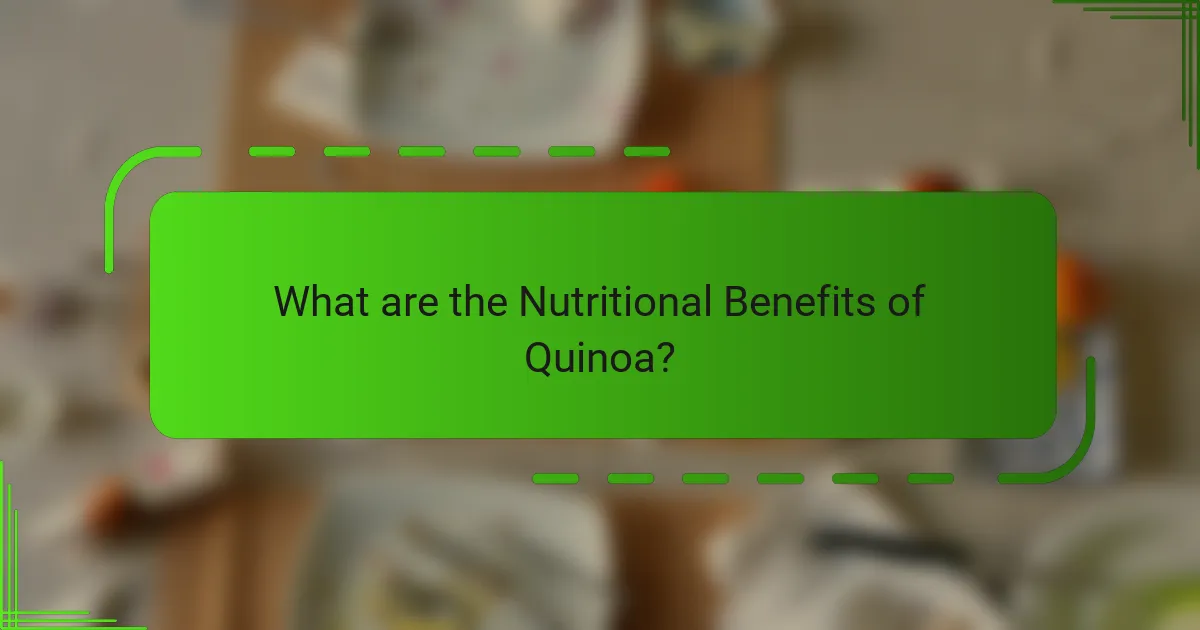Quinoa is a highly nutritious grain recognized for its numerous health benefits, including being rich in protein and dietary fiber. It contains all nine essential amino acids, important vitamins, and minerals such as magnesium and iron, making it a valuable food choice for those with gluten intolerance due to its gluten-free nature. The article provides an overview of quinoa’s health benefits, including its role in supporting heart health, weight management, and blood sugar regulation. Additionally, it outlines various cooking methods for quinoa, such as boiling, steaming, baking, and using a rice cooker, while emphasizing the importance of rinsing to remove bitterness and enhance flavor.

What are the Nutritional Benefits of Quinoa?
Quinoa is a highly nutritious grain known for its health benefits. It is rich in protein, containing all nine essential amino acids. Quinoa is also a good source of dietary fiber, which aids digestion. Additionally, it provides important vitamins and minerals, including magnesium, iron, and B vitamins. Quinoa is gluten-free, making it suitable for those with gluten intolerance. It has a low glycemic index, which helps in blood sugar regulation. Studies show that quinoa consumption can support heart health and weight management. Its antioxidant properties may help reduce inflammation in the body.
How does Quinoa compare to other grains in terms of nutrition?
Quinoa is nutritionally superior to many other grains. It contains all nine essential amino acids, making it a complete protein. In contrast, most grains lack one or more essential amino acids. Quinoa has a higher fiber content than rice and wheat, promoting better digestion. It also boasts a lower glycemic index, which helps regulate blood sugar levels. Additionally, quinoa is rich in vitamins and minerals, including magnesium, iron, and B vitamins. Compared to white rice, quinoa has nearly twice the protein and five times the fiber. This nutrient profile makes quinoa an excellent choice for a balanced diet.
What essential nutrients are found in Quinoa?
Quinoa contains essential nutrients including protein, fiber, vitamins, and minerals. It is a complete protein, providing all nine essential amino acids. Quinoa is high in dietary fiber, which aids digestion. It also contains B vitamins such as B1 (thiamine), B2 (riboflavin), and B6 (pyridoxine). Additionally, quinoa is rich in minerals like magnesium, phosphorus, and iron. The presence of antioxidants in quinoa contributes to its health benefits. Studies show that quinoa has a low glycemic index, making it suitable for blood sugar management.
Why is Quinoa considered a complete protein?
Quinoa is considered a complete protein because it contains all nine essential amino acids. These amino acids are necessary for human health but cannot be produced by the body. Quinoa has a balanced profile of proteins, making it unique among plant-based foods. Its protein content is approximately 8 grams per cooked cup. Additionally, it provides other nutrients such as fiber, vitamins, and minerals. Research shows that quinoa can support muscle repair and growth due to its amino acid composition. This makes quinoa an excellent choice for vegetarians and vegans seeking protein sources.
What health benefits does Quinoa provide?
Quinoa provides numerous health benefits, including high protein content and essential amino acids. It contains all nine essential amino acids, making it a complete protein source. Quinoa is rich in dietary fiber, which aids digestion and promotes gut health. It has a low glycemic index, helping to regulate blood sugar levels. The grain is also packed with vitamins and minerals, including magnesium, iron, and B vitamins. Research shows that quinoa consumption can reduce the risk of chronic diseases, such as heart disease and type 2 diabetes. Additionally, quinoa is gluten-free, making it suitable for those with gluten sensitivities.
How can Quinoa support heart health?
Quinoa can support heart health by providing essential nutrients and promoting healthy cholesterol levels. It is high in fiber, which can lower cholesterol and improve heart health. Quinoa contains antioxidants, such as flavonoids, that help reduce inflammation. Additionally, it is rich in magnesium, which can help regulate blood pressure. A study published in the “American Journal of Clinical Nutrition” found that whole grains, including quinoa, are linked to a reduced risk of heart disease. The presence of healthy fats in quinoa also contributes to cardiovascular health. These attributes collectively make quinoa a heart-healthy food choice.
What role does Quinoa play in weight management?
Quinoa plays a significant role in weight management due to its high protein and fiber content. This combination helps increase feelings of fullness, which can reduce overall calorie intake. Quinoa contains about 8 grams of protein per cooked cup. It also has approximately 5 grams of dietary fiber, promoting digestive health. Research indicates that protein-rich foods can enhance satiety and decrease hunger levels. Additionally, quinoa is a low glycemic index food, which means it causes a slower rise in blood sugar levels. This property can help regulate appetite and prevent overeating. Overall, quinoa is a nutritious option for those aiming to manage their weight effectively.
How does the fiber content in Quinoa affect digestion?
The fiber content in quinoa significantly enhances digestion. Quinoa is a rich source of dietary fiber, containing about 2.8 grams per 100 grams. This fiber aids in promoting regular bowel movements. It helps prevent constipation by adding bulk to the stool. Increased fiber intake can also support gut health by feeding beneficial gut bacteria. Research indicates that high-fiber diets can lower the risk of digestive disorders. Additionally, fiber slows down the digestion process, which can improve nutrient absorption. Overall, the fiber in quinoa plays a crucial role in maintaining a healthy digestive system.
What types of fiber are present in Quinoa?
Quinoa contains two main types of fiber: soluble fiber and insoluble fiber. Soluble fiber helps regulate blood sugar levels and lowers cholesterol. Insoluble fiber aids in digestive health by promoting regularity. Research indicates that quinoa’s fiber content contributes to overall health benefits. A serving of quinoa typically provides about 2.5 grams of fiber. This fiber composition supports heart health and digestive function.
How does fiber in Quinoa contribute to overall health?
Fiber in quinoa contributes to overall health by promoting digestive health and aiding in weight management. It helps regulate bowel movements and prevents constipation due to its high fiber content of about 2.8 grams per 100 grams of cooked quinoa. This fiber also supports gut health by acting as a prebiotic, feeding beneficial gut bacteria. Additionally, fiber increases satiety, which can help control appetite and reduce overall calorie intake. Studies indicate that a high-fiber diet can lower the risk of chronic diseases such as heart disease and type 2 diabetes. Therefore, incorporating quinoa into a balanced diet can significantly enhance health outcomes related to digestion and weight management.

What are the Different Cooking Methods for Quinoa?
Quinoa can be cooked using several methods. The most common method is boiling. To boil quinoa, combine one part quinoa with two parts water in a pot. Bring the mixture to a boil, then reduce heat and simmer for about 15 minutes. Another method is steaming. Steaming quinoa involves placing it in a steamer basket over boiling water for about 15 minutes. A third method is baking. For baking, quinoa can be mixed with broth and placed in a covered dish in the oven at 375°F for about 30 minutes. Lastly, quinoa can be prepared in a rice cooker. This method requires the same water-to-quinoa ratio as boiling. Each cooking method results in fluffy, nutritious quinoa, making it a versatile grain option.
How can Quinoa be prepared for optimal taste and texture?
To prepare quinoa for optimal taste and texture, rinse it thoroughly before cooking. Rinsing removes the bitter saponins that can affect flavor. Use a ratio of two cups of water to one cup of quinoa for cooking. Bring the water to a boil, then add the rinsed quinoa. Reduce the heat to low and cover the pot. Simmer for about 15 minutes until the quinoa absorbs the water. Fluff the quinoa with a fork after cooking to enhance its texture. For added flavor, consider toasting the quinoa in a dry pan before boiling. This method enhances the nutty taste. Adding broth instead of water can also improve flavor. These techniques ensure a pleasant taste and fluffy texture.
What are the steps to cook Quinoa on the stovetop?
Rinse one cup of quinoa under cold water to remove bitterness. Combine the rinsed quinoa with two cups of water or broth in a saucepan. Bring the mixture to a boil over medium-high heat. Once boiling, reduce the heat to low and cover the saucepan. Simmer for about 15 minutes until the quinoa absorbs the liquid. After cooking, remove the saucepan from heat and let it sit, covered, for 5 minutes. Fluff the quinoa with a fork before serving. This method yields a light and fluffy texture, ideal for various dishes.
Can Quinoa be cooked in a rice cooker or instant pot?
Yes, quinoa can be cooked in a rice cooker or instant pot. Both appliances simplify the cooking process. In a rice cooker, use a 2:1 water-to-quinoa ratio. The quinoa cooks evenly and absorbs moisture well. In an instant pot, a 1:1.25 water-to-quinoa ratio is recommended. This method reduces cooking time significantly. Cooking quinoa in these appliances yields fluffy and well-cooked grains. Many users report successful outcomes with both methods.
What are some creative ways to incorporate Quinoa into meals?
Quinoa can be creatively incorporated into meals in various ways. Use it as a base for salads, combining it with vegetables and a dressing. Incorporate quinoa into soups for added texture and nutrition. Blend it into smoothies for a protein boost. Use quinoa as a filling for stuffed peppers or zucchini. Create quinoa patties or burgers by mixing it with beans and spices. Add quinoa to breakfast bowls with fruits and nuts for a nutritious start. Use it in grain bowls with proteins and sauces for a complete meal. Quinoa can be used in desserts, such as puddings or as a topping for yogurt.
How can Quinoa be used in salads and bowls?
Quinoa can be used as a base or ingredient in salads and bowls. It adds a nutty flavor and a chewy texture. Cooked quinoa can replace rice or pasta in many dishes. It pairs well with vegetables, beans, and dressings. Nutritionally, quinoa is rich in protein and fiber. One cup of cooked quinoa contains about 8 grams of protein and 5 grams of fiber. This makes it a filling addition to meals. Quinoa also absorbs flavors well, enhancing the overall taste of salads and bowls.
What are some unique recipes that feature Quinoa?
Quinoa can be used in various unique recipes. One popular recipe is Quinoa Salad with Black Beans and Mango. This dish combines cooked quinoa, black beans, diced mango, red onion, and cilantro. The salad is dressed with lime juice and olive oil for a fresh flavor.
Another unique recipe is Quinoa Stuffed Bell Peppers. This dish features bell peppers filled with a mixture of cooked quinoa, diced tomatoes, corn, and spices. The stuffed peppers are baked until tender, making for a nutritious meal.
Quinoa can also be used in breakfast dishes. Quinoa Porridge is a unique option that involves cooking quinoa in almond milk with cinnamon and maple syrup. Topped with fruits and nuts, it serves as a healthy breakfast alternative.
For a dessert, Quinoa Chocolate Chip Cookies offer a unique twist. These cookies incorporate cooked quinoa into the dough, adding protein and texture. They are baked until golden brown, providing a nutritious treat.
Each of these recipes showcases quinoa’s versatility and nutritional benefits.

What Tips Should You Consider When Cooking Quinoa?
Rinse quinoa before cooking to remove bitterness from saponins. Use a ratio of 2 cups of water for every 1 cup of quinoa. Bring the water to a boil, then reduce to a simmer. Cover the pot and cook for 15 minutes or until water is absorbed. Fluff the quinoa with a fork after cooking. Let it sit for 5 minutes before serving. Adding salt or spices can enhance the flavor. Toasting quinoa in a dry pan before cooking adds a nutty taste.
How can you enhance the flavor of Quinoa?
To enhance the flavor of quinoa, cook it in broth instead of water. Using vegetable or chicken broth adds depth and richness. Additionally, toasting quinoa in a dry pan before cooking can bring out a nuttier flavor. Incorporating spices such as cumin or garlic powder during cooking enhances its taste. Adding herbs like parsley or cilantro after cooking provides freshness. Mixing in sautéed vegetables or nuts can also elevate the overall flavor profile. These methods are commonly recommended by culinary experts for improving quinoa’s taste.
What spices and ingredients pair well with Quinoa?
Quinoa pairs well with various spices and ingredients. Common spices include cumin, coriander, and paprika. Fresh herbs like parsley, cilantro, and basil enhance its flavor. Ingredients such as garlic, onion, and lemon juice add depth. Vegetables like bell peppers, spinach, and tomatoes complement quinoa’s texture. Nuts and seeds, including almonds and pumpkin seeds, provide crunch. These combinations create nutritious and flavorful dishes.
How can you store cooked Quinoa for future use?
Store cooked quinoa in an airtight container. Ensure it cools to room temperature before sealing. Refrigerate the container for up to five days. For longer storage, freeze cooked quinoa in a freezer-safe bag. It can last up to three months in the freezer. Label the container with the date for easy tracking. Thaw frozen quinoa in the refrigerator before reheating. Reheat in a microwave or stovetop with a splash of water to restore moisture.
What common mistakes should you avoid when cooking Quinoa?
Rinsing quinoa before cooking is essential to remove its natural coating, called saponin. Not rinsing can result in a bitter taste. Using too much water can lead to mushy quinoa. The ideal water-to-quinoa ratio is 2:1. Cooking quinoa at too high a temperature may cause uneven cooking. It’s best to simmer quinoa gently. Overcooking can also result in a loss of texture. Cooking it for about 15 minutes is usually sufficient. Not allowing quinoa to rest after cooking can lead to a gummy texture. Letting it sit for 5 minutes before fluffing helps improve the consistency.
How can overcooking affect the texture of Quinoa?
Overcooking quinoa results in a mushy texture. When quinoa is cooked beyond the recommended time, the grains lose their firm structure. The outer germ layer separates, causing the grains to become sticky. This change occurs because quinoa absorbs too much water. Properly cooked quinoa should have a fluffy texture with a slight bite. Overcooked quinoa lacks this desirable quality. Studies show that cooking quinoa for 15 minutes yields optimal texture. Cooking it for longer can lead to undesirable consistency.
What should you watch out for to prevent bitterness in Quinoa?
To prevent bitterness in quinoa, rinse it thoroughly before cooking. Quinoa has a natural coating called saponins, which can impart a bitter taste. Rinsing removes most of these saponins. Use cold water and a fine-mesh strainer for effective rinsing. This process is recommended by the Whole Grains Council. Proper rinsing ensures a pleasant flavor and enhances the overall eating experience.
Quinoa is a highly nutritious grain known for its numerous health benefits, including being a complete protein source, rich in dietary fiber, and packed with essential vitamins and minerals. This article provides an overview of quinoa’s nutritional benefits, highlighting its role in heart health, weight management, and digestive support. Additionally, it explores various cooking methods, tips for optimal preparation, and unique recipe ideas to incorporate quinoa into meals. The content emphasizes the importance of proper cooking techniques to enhance flavor and texture while avoiding common mistakes.